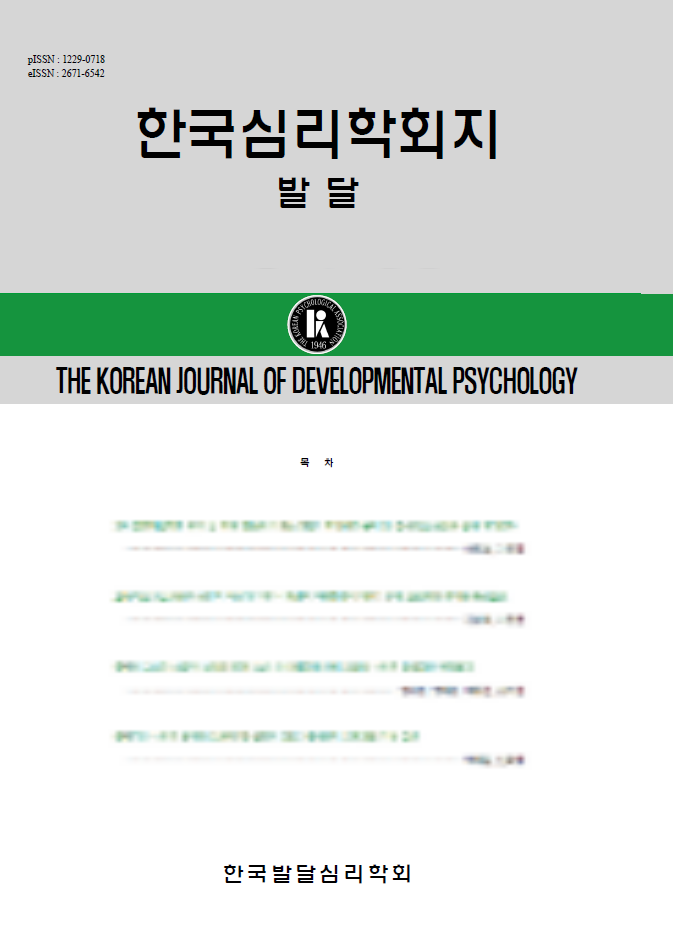open access
메뉴
open access
메뉴 ISSN : 1229-0718
ISSN : 1229-0718

본 연구는 연합결핍가설과 이중처리모델을 바탕으로 학습유형과 연합증강 유형이 청년과 노인의 연합기억에 미치는 영향을 확인하고자 하였다. 실험 1에서 청년과 노인을 대상으로 연합재인과제를 사용하여 학습유형(단일학습, 반복학습, 학습-검사 반복)에 따른 수행 차이를 확인하였다. 그 결과 청년은 반복학습과 학습-검사 반복 수행 조건에서 연합재인율의 상승을 나타내었고, 노인은 반복학습에서는 연합재인율이 상승을 보였지만 학습-검사 반복 조건에서는 오경보의 증가를 나타내었다. 실험 2에서는 변형된 연합재인과제를 사용하여 연합증강의 유형에 따른 수행 차이를 알아보았다. 연구 결과 연령에 관계없이 항목증강은 오경보율을, 연합증강은 정확재인율을 상승시켰다. 종합하여 볼 때 학습유형의 경우 청년은 모든 반복조건에서, 노인은 반복학습 조건만 연합재인기억 수행이 증진되는 것으로 나타났으며 증강 유형에 따른 연합기억 수행의 증진에 있어서는 조건에 따른 연령차가 나타나지 않았다.
The purpose of the study was to examine how age affects associative memory performance for different types of learning and associative strengthening. In study 1, after the participants of young and old group studied a list of paired-associates in one of three study types (simple, repeat, and repeat-test), the recognition test was given for a total of 48 paired-associates immediately after the study. The results showed that young participants’ recognition memory was highest in the repeat-test condition, whereas the old counterparts performed best in the repeat condition. And in study 2, accuracy and false alarm rates were analyzed for recognition memory performance between the two age groups for paired items of varied associative strengthening levels. It was shown that item-strengthening increases false alarm rates, while associative-strengthening facilitates correct recognition in both age groups. The limitations and further implications of these findings were discussed.
박태진 (2003). 한국어 단어의 주관적 빈도 추정치 및 단어 재인에 미치는 빈도 효과. 한국심리학회지: 실험, 19(2), 349-366.
이한별 (2013). 연합 재인 과제에 나타나는 연령에 따른 기억 수행 변화의 특성. 서울대학교석사학위논문.
장정동 (2013). 망상을 경험하는/경험하지 않는조현병 환자의 연합재인기억과 기억확신. 서강대학교 석사학위논문.
Aron, S. B. (2001) On the dual effects of repetition on false recognition. Journal of experimental psychology, 27, 941-947.
Bastin, C., & Van der Linden, M. (2006). The effects of aging on the recognition of different types of association. Experimental Aging Research, 32, 61-77.
Buchler, N. G., Light, L. L., & Reder, L. M. (2008). Memory for items and associations:Distinct representations and processes in associative recognition. Journal of Memory and Language, 559, 183-199.
Buchler, N. G., Faunce, P., Light, L. L., Gottfredson, N., & Reder, L M. (2011). Effects of repetition on associative recognition in young and older adults: Item and associative strengthening. Psychology and Aging. 26(1), 111-126.
Budson, A. E., Sullivan, A. L., Mayer, E., Daffner, K. R., Black, P. M., & Schacter, D. L. (2002). Suppression of false recognition in Alzheimer’s disease and in patients with frontal lobe lesions. Brain, 125, 2750-2765.
Castel, A. D., & Craik, F. I. M. (2003). The effect of aging and divided attention on memory for item and associative information. Psychology and Aging, 18, 873-885.
Chalfonte, B. L., & Johnson, M. K. (1996). The effects of aging and divided attention of memory for item and associative information. Psychology and Aging, 18, 873-885.
Cohn, M., Emrich, S. M., & Moscovitch, M. (2008). Age-related deficits in associative memory: The influence of impaired strategic retrieval. Psychology and Aging, 23, 93-103.
Diana, R. A., Reder, L. M., Arndt, J., & Park, H. (2006). Models of recognition: A review of arguments in favor of a dual-process account. Psychonomic Bulletin & Review, 13, 1-21.
Dunlosky, J., & Rawson, K. A. (2005). Why does rereading improve metacomprehension accuracy? Evaluation the levels-of-disruption hypothesis for the rereading effect. Discourse Processes, 40, 37-56.
Higham, P. A., & Vokey, J. R. (2004). Illusory recollection and dual-process models of recognition memory, Quarterly Journal of Experimental Psychology, 57, 714-744.
Kelley, R., & Wixted, J. T. (2001). On the nature of associative information in recognition memory. Journal of Experimental Psychology:Learning, memory, and Cognition, 27, 701-722.
Kensinger, E. A., & Schacter, D. L. (1999). When true memories suppress false memories: Effects of ageing. Cognitive Neuropsychology, 16, 399-415.
Kilb, A., & Naven-Benjamin, M. (2011). The effect of pure pair repetition on younger and older adults’ associative memory. Journal of Experimental Psychology: Learning, Memory, and Cognition, 37(3), 706-719.
Light, L. L., Chung, C., Pendergrass, R., & Van Ocker, J. C. (2006). Effects of repetition and response deadline on item recognition in young and older adults. Memory & Cognition, 34, 335-343.
Light, L. L., Patterson, M. M., Chung, C., & Healy, M. R. (2004). Effects of repetition and response deadline on associative recognition in young and older adults. Memory & Cognition, 32(7), 1182-1193.
Mayes, A. R., Holdstock, J. S., Issac, C. L., Montaldi, D., Gummer, A., Cariga, P., Dounes, J. J., Tsivilis, D., Qiyong, Gong, & Norman, K. A. (2004). Associative recognition in a patient with selective hippocampal lesions and relatively normal item recognition. Hippocampus, 14, 763-784.
Rawson, K. A., & Dunlosky, J. (2011). Optimizing schedules of retrieval practice for durable and efficient learning: How much is enough? Journal of Experimental Psychology: General, 140(3), 283-30.
Roediger, H. H., & Butler, A. C. (2011). The critical role of retrieval practice in long-term retention. Trends in Cognitive Sciences, 15(1), 20-27.
Zaragoza, S. M., Mitchell. J. K. (1996). Repeated Exposure to Suggestion and the Creation of False Memories. Psychological Science, 7, 294-300.
